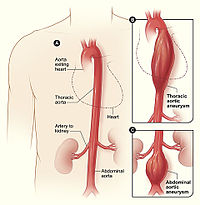
Photo from wikipedia
BACKGROUND The present study assessed whether descending thoracic aorta growth can be measured reliably by volumetric analysis using multi-detector row computed tomography (MDCT) and whether growth influences the need for… Click to show full abstract
BACKGROUND The present study assessed whether descending thoracic aorta growth can be measured reliably by volumetric analysis using multi-detector row computed tomography (MDCT) and whether growth influences the need for future aortic interventions in survivors of acute type A aortic dissection. METHODS A total of 51 patients (58 ± 11 years, 61% male) who underwent surgery for type A aortic dissection with ≥2 postoperative MDCT scans ≥5 months apart were included. Volumetric analysis of the descending thoracic aorta was performed with acceptable intraobserver variability. Growth of the complete, false and true lumen was estimated in ml/year and defined as slow growth (≤average growth) or fast growth (>average growth). RESULTS The complete lumen volume increased from 133 ± 8 ml to 163 ± 9 ml after 3.5 years follow-up (p < 0.001), with an average growth rate of 6.1 ml/year. The false lumen volume increased from 81 ± 7 ml to 106 ± 12 ml (p = 0.018) with an average growth rate of 2.8 ml/year. The true lumen changed only slightly from 59 ± 4 ml to 65 ± 8 ml (p = 0.205). Five-year freedom from descending thoracic aorta intervention was significantly lower in patients with above-average growth of the complete lumen (80 ± 9%) compared to slow growth (100%; p = 0.003). Similar observations were made for the false lumen (fast: 74 ± 12% vs. slow: 100%; p = 0.042). CONCLUSIONS Increased growth of the false lumen of the descending thoracic aorta after type A aortic dissection was associated with a higher risk of secondary interventions.
Journal Title: Journal of cardiovascular computed tomography
Year Published: 2017
Link to full text (if available)
Share on Social Media: Sign Up to like & get
recommendations!